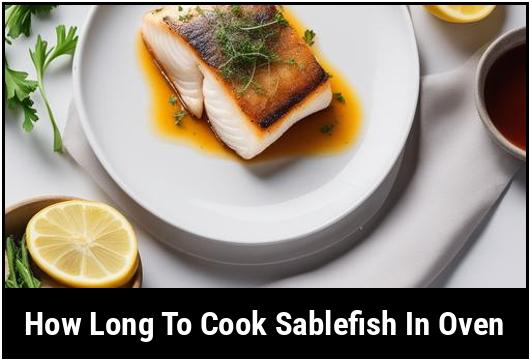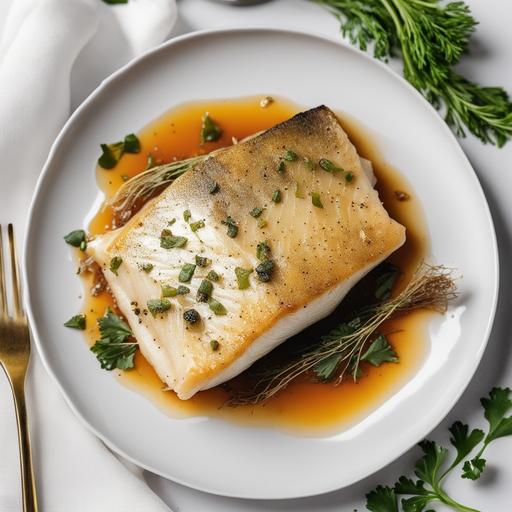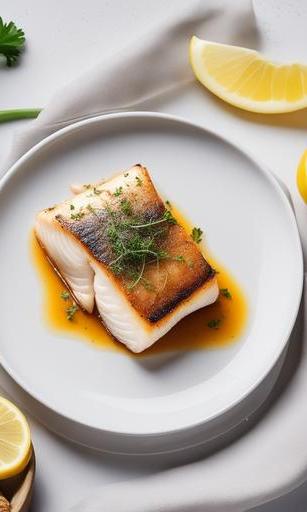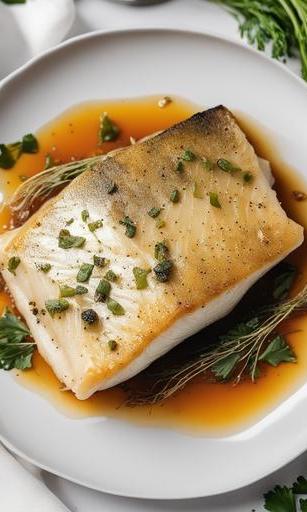[GUIDE] How Long To Cook Sablefish In Oven

Sablefish, also known as black cod or butterfish, is a delicately flavored fish known for its rich and buttery texture. Cooking sablefish in the oven is a popular way to prepare it, as it allows for even heat distribution and ensures a moist and tender final result.
In this article, we will explore the ideal cooking time and temperature for sablefish in the oven, as well as provide detailed instructions on how to prepare, cook, and serve this delicious fish. We’ll also delve into the science behind cooking sablefish and provide troubleshooting tips for any cooking mishaps that may occur.
So, let’s dive in and learn how to cook sablefish to perfection!
Quick Answer: How Long To Cook Sablefish In Oven
To cook sablefish in the oven, preheat it to 425°F (220°C). Place the sablefish fillets on a baking sheet lined with parchment paper or aluminum foil. Bake for approximately 12-15 minutes, or until the internal temperature of the fish reaches 145°F (63°C) and the flesh is opaque and flakes easily with a fork.
Key Takeaways
- Preheat the oven to 425°F (220°C).
- Cook the sablefish for approximately 12-15 minutes.
- Internal temperature should reach 145°F (63°C).
- The fish should be opaque and flake easily with a fork.
The Science Of Cooking Sablefish

Understanding the science behind cooking sablefish can help you achieve the best results. Sablefish contains a good amount of fat, which contributes to its rich flavor and buttery texture. When cooked, the fat helps keep the fish moist and prevents it from becoming dry.
The ideal cooking temperature for sablefish is relatively high, around 425°F (220°C). This high temperature allows the fish to cook quickly and evenly, ensuring that it retains its moisture and delicate flavor. Cooking sablefish at a lower temperature may result in the fish taking longer to cook and potentially drying out.
Choosing Sablefish
When selecting sablefish for cooking, look for fillets that are shiny, with firm flesh and a fresh oceanic smell. The flesh should not be discolored, slimy, or have a strong, fishy odor. If you have the option, choose wild-caught sablefish over farm-raised, as the wild-caught variety tends to have a more robust flavor.
Preparing Sablefish

Before cooking sablefish, it’s important to properly prepare it. Here’s how to do it:
-
Thaw the sablefish fillets if they are frozen. Place them in the refrigerator overnight or use the defrost option on your microwave if you’re short on time.
-
Once thawed, pat the fillets dry with paper towels. Removing excess moisture will help the fish cook evenly and prevent it from becoming watery.
-
Season the sablefish with salt and pepper or your preferred seasoning blend. You can also marinate the fish for added flavor. Some popular marinade options for sablefish include soy sauce, ginger, and garlic.
-
If desired, you can also add a squeeze of lemon juice or a drizzle of olive oil to enhance the flavor of the fish.
Ideal Cooking Temperature For Sablefish
As mentioned earlier, the ideal cooking temperature for sablefish is 425°F (220°C). This high heat helps to quickly cook the fish, resulting in a moist and tender final product. Cooking sablefish at a lower temperature may increase the cooking time and can potentially lead to a dry and overcooked dish.
Sablefish Cooking Time

The cooking time for sablefish in the oven can vary depending on the thickness of the fillets. As a general guideline, sablefish fillets that are around 1 inch thick will take approximately 12-15 minutes to cook through.
It’s important to note that cooking times can vary depending on individual ovens, so it’s best to use a food thermometer to ensure the desired doneness. The internal temperature of the cooked sablefish should reach 145°F (63°C) to ensure that it is safe to eat.
Cooking Techniques
Now that you know the ideal cooking temperature and time for sablefish, let’s explore some cooking techniques you can use to enhance its flavor and texture.
-
Baking: Baking sablefish in the oven is a simple and effective method. Follow the instructions above to preheat the oven and cook the fish until it is opaque and flakes easily with a fork.
-
Broiling: Broiling sablefish can give it a delicious crispy exterior while keeping the interior moist and tender. Preheat your broiler and place the fish on a broiler pan or baking sheet lined with foil. Broil for approximately 8-10 minutes, keeping a close eye to prevent burning.
-
Grilling: Grilling sablefish adds a smoky flavor and beautiful grill marks. Preheat the grill to medium-high heat and lightly oil the grates. Place the fish directly on the grill and cook for about 6-8 minutes per side, or until it reaches the desired doneness.
-
Pan-searing: Pan-searing sablefish creates a flavorful crust while retaining its moisture. Heat a tablespoon of oil in a skillet over medium-high heat. Place the fish in the hot pan and cook for approximately 4-5 minutes per side, or until it is opaque and flakes easily.
Choose the cooking technique that suits your preferences and equipment availability. Each method will produce a slightly different flavor and texture, so feel free to experiment and find your favorite.
Monitoring And Troubleshooting

While cooking sablefish in the oven, it’s important to monitor its progress to ensure it doesn’t overcook or dry out. Here are a few tips to help you avoid common cooking mishaps:
-
Use a food thermometer: This essential tool will help you determine the internal temperature of the fish accurately. Insert the thermometer into the thickest part of the fillet, making sure it doesn’t touch the bone or the baking sheet.
-
Don’t overcrowd the baking sheet: Leaving enough space between the fillets will allow for even heat circulation and prevent steaming. Overcrowding can lead to uneven cooking and a less desirable texture.
-
Check for doneness with a fork: Gently insert a fork into the thickest part of the fillet and twist it slightly. If the fish flakes easily and appears opaque, it is cooked. If it still looks translucent or resists flaking, it needs more time in the oven.
-
Adjust cooking time for thinner or thicker fillets: Thinner fillets may require less time, while thicker ones may need a bit more. Keep an eye on the fish as it cooks and adjust the cooking time accordingly.
Sablefish Cooking Instructions
Now, let’s dive into the step-by-step instructions for cooking sablefish in the oven.
-
Preheat your oven to 425°F (220°C) and line a baking sheet with parchment paper or aluminum foil for easy cleanup.
-
Thaw the sablefish fillets if they are frozen. Pat them dry with paper towels to remove any excess moisture.
-
Season the fillets with salt and pepper or your preferred seasoning blend. You can also marinate the fish if desired.
-
Place the seasoned sablefish fillets on the prepared baking sheet, leaving some space between them.
-
Transfer the baking sheet to the preheated oven and bake for approximately 12-15 minutes, or until the internal temperature of the fish reaches 145°F (63°C).
-
Check the doneness of the sablefish by gently inserting a fork into the thickest part of the fillet and twisting it slightly. If the fish flakes easily and appears opaque, it is done. If it still looks translucent or resists flaking, it needs more time in the oven.
-
Once the sablefish is cooked to your desired level of doneness, remove it from the oven and let it rest for a few minutes before serving. This allows the juices to redistribute throughout the fish, ensuring maximum flavor and tenderness.
Variations

Once you have mastered the basic technique of cooking sablefish in the oven, you can experiment with different flavors and ingredients to create variations and add your personal touch. Here are a few ideas to get you started:
-
Asian-inspired: Marinate the sablefish in a mixture of soy sauce, ginger, garlic, and a touch of honey. Sprinkle with sesame seeds before baking for an Asian-inspired twist.
-
Mediterranean: Season the sablefish with a blend of dried herbs such as oregano, thyme, and rosemary. Drizzle with olive oil and top with sliced tomatoes and Kalamata olives before baking.
-
Citrus-infused: Squeeze fresh lemon or lime juice over the seasoned sablefish before baking to add a bright and tangy flavor. Garnish with fresh herbs like parsley or dill.
-
Spicy: Create a spicy kick by rubbing the sablefish fillets with a mixture of chili powder, paprika, cayenne pepper, and a hint of cumin. Serve with a cooling avocado or yogurt sauce.
Feel free to get creative and combine different ingredients and flavors to suit your taste preferences.
When Things Go Wrong
Sometimes, despite your best efforts, things can go wrong while cooking sablefish. Here are a few common issues and how to troubleshoot them:
-
Overcooking: If you accidentally overcook the sablefish, it can become dry and tough. To salvage the dish, you can flake the fish and use it in seafood salads, pasta dishes, or fish cakes, where the added moisture from other ingredients can help rehydrate the fish.
-
Undercooking: Undercooked sablefish may look translucent and have a raw texture. If you realize the fish is undercooked after taking it out of the oven, simply return it to the oven and continue cooking for a few more minutes until it reaches the desired doneness.
-
Fishy odor: If the sablefish has a strong fishy odor even after cooking, it may not be as fresh as it should be. Avoid consuming fish that smells off, as it can indicate spoilage.
-
Sticking to the baking sheet: If the sablefish sticks to the baking sheet, it can be challenging to serve without breaking. To prevent sticking, make sure to line the baking sheet with parchment paper or aluminum foil and lightly oil it before placing the fillets.
Remember, practice makes perfect, and even professional chefs encounter cooking mishaps from time to time. Don’t be discouraged if things don’t go as planned and use these troubleshooting tips to help you improve your skills.
Serving Sablefish

Once your sablefish is cooked to perfection, it’s time to serve and enjoy it. Here are a few serving ideas to complement the delicate flavors of this delicious fish:
-
Serve the sablefish over a bed of steamed rice or quinoa and accompany it with roasted or steamed vegetables for a wholesome and nutritious meal.
-
Pair the sablefish with a light salad dressed in vinaigrette to create a refreshing and well-balanced dish.
-
Serve the sablefish with a side of roasted potatoes or mashed cauliflower for a comforting and satisfying meal.
-
Squeeze fresh lemon or lime juice over the fish right before serving to add a burst of brightness.
-
Garnish the sablefish with fresh herbs, such as parsley, dill, or chives, to enhance its visual appeal and add a fresh aroma.
Best Practices For Sablefish Cooking
To ensure consistently delicious results when cooking sablefish in the oven, here are a few best practices to keep in mind:
-
Thaw the fish properly before cooking to ensure even cooking.
-
Pat the fillets dry before seasoning to prevent excess moisture.
-
Use a food thermometer to monitor the internal temperature and avoid overcooking.
-
Avoid overcrowding the fillets on the baking sheet to allow for even heat distribution.
-
Experiment with different flavors and cooking techniques to keep things interesting.
-
Cook with wild-caught sablefish for a more robust and flavorful experience.
Remember that cooking times and results may vary slightly due to individual ovens and preferences. Adjust the cooking time and temperature accordingly to achieve your desired level of doneness.
Conclusion
Cooking sablefish in the oven is a simple and rewarding process that can result in a perfectly moist and tender fish. By following the recommended cooking time and temperature, along with proper preparation and seasoning, you can create a delicious and flavorful dish.
Whether you choose to bake, broil, grill, or pan-sear your sablefish, the key is to ensure it reaches an internal temperature of 145°F (63°C) and appears opaque and flaky. Don’t be afraid to experiment with different flavors and ingredients to create your own unique variations.
Remember to keep an eye on the sablefish while it cooks, use a food thermometer for accuracy, and address any troubleshooting issues that may arise. With practice and patience, you’ll soon become a master at cooking sablefish in the oven, delighting yourself and your guests with this delectable seafood.
FAQS
What Is Sablefish?
Sablefish, also known as black cod, is a deep-water fish found in the North Pacific Ocean.
How Long Does It Take To Cook Sablefish In The Oven?
Sablefish can be cooked in the oven for 12-15 minutes at 450°F (230°C) or until the internal temperature reaches 145°F (63°C).
What Are Some Tips For Cooking Sablefish In The Oven?
You can brush sablefish with a mixture of olive oil and herbs or lemon juice before cooking to enhance its flavor. Additionally, you can wrap the fish with aluminum foil or parchment paper to prevent it from drying out.
What Are Some Alternative Cooking Methods For Sablefish?
Sablefish can also be poached, grilled, or smoked for a unique flavor. Poaching involves submerging the fish in simmering liquid, while grilling allows you to add a smoky flavor. Smoking involves curing the fish with salt and then smoking it over wood chips.
How Can I Tell If The Sablefish Is Cooked Properly?
The fish should have a flaky texture and be opaque throughout. You can check the internal temperature with a meat thermometer to ensure it has reached 145°F (63°C).
Sources
About the Author Jenny
I'm Jenny, a housewife with an unwavering passion for food. My culinary journey began with my grandmother's kitchen, and it's now a full-fledged food blog. I've turned my love for cooking into a creative outlet, sharing recipes and stories with a global community of fellow food enthusiasts. It's proof that being a housewife can also mean pursuing your passions and savoring life's delectable moments.
